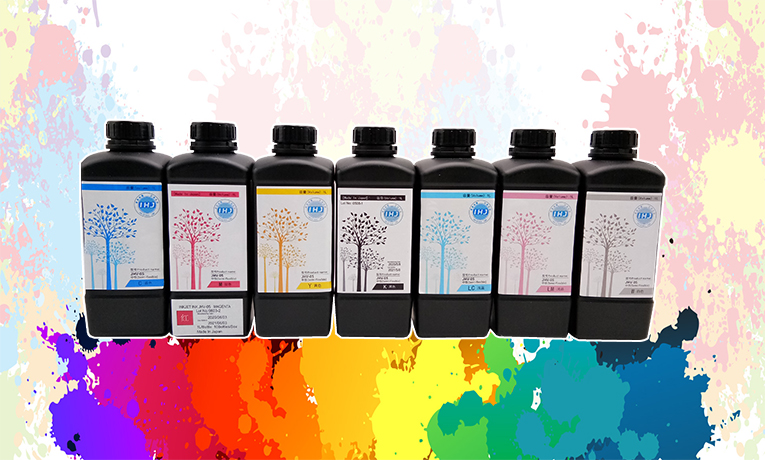An Overview of UV-curable Ink
An Overview of UV-curable Ink

The introduction of UV-curable ink chemistry transformed wishful thinking into reality for the vast majority of users who wanted to profit from digital print technology. Although these formulas were well-established in analog contexts, there were obstacles to overcome before they could be used in the mainstream inkjet industry. Around the year 2000, UV potential was introduced to the fast expanding wide-format segment, ushering in a general shift in how display and point-of-purchase applications might be printed directly to rigid surfaces. In the years afterwards, this critical technology has evolved to the point where UV-curable practicalities are no longer limited to ink products, but are now used in a wide range of industries where fluid deposition plays a significant role.
These problems have been numerous and varied for UV-curable engine producers, and they continue to grow as production needs become more adaptable and time-sensitive. Alternative ink technologies are available for certain applications, such as the textile and garment industries, the photographic and fine art industries, and occupations where solvent or latex chemistries are adequate. But, for the most part, the inclusion of ultraviolet energy into modern printing equipment in the form of ink and curing has resulted in a shift in printing machines that handle not only ornamental but also practical and industrial processes.
The combination of ink to the material surface was not straightforward in UV’s early iterations in the digital print arena because, unlike solvent-based chemistry, UV-curable inks do not bond with the media itself, which meant adhesion and cracking of finished prints were sometimes unavoidable. Most scientific breakthroughs do not happen overnight, and the flexibility of today’s print engines, as well as the behavior of their inks and curing systems, is the result of years of work, some of which was based on trial and error.
When UV-curable chemistry is incorporated into a print engine, there are two important issues. The first is the ink itself, which must have the necessary rheology and viscosity to work with the printhead and nozzle density selected; the second is the curing method’s efficacy, which is ultimately responsible for the finished appearance, including adherence and color accuracy. The main reason for UV-curable formulations’ rapid acceptance in the digital printing market was that they offered a practical solution that could be utilized on a variety of substrates, both thick and thin, rigid and flexible. The limits stemmed from the type of printing machine used and the end product’s requirements.
The absence of VOCs and a significant reduction in air pollution were among the advantages considered by UV-curable ink, as was the advantage of generating faster-operating speeds due to instant curing after jetting; unlike alternative chemistries, drying each print did not rely on a conventional and, often, time-consuming heat source that needed to follow the actual laying down of the ink. Because the ink remained liquid until it is dried, printing machine maintenance was decreased because the evaporation of solvents in the printheads, which may cause clogging and nozzle damage, was no longer an issue.Furthermore, the chemistry’s high viscosity simplified the quality of droplet creation and maintained fixed accuracy when cured, allowing print engines to run at high speeds without sacrificing quality.
UV-curable technologies have largely addressed their drawbacks, as the viscosity of the inks can make it difficult to achieve a smooth surface. Due to the fact that the cured ink does not key with the material surface, the process must ensure that the proper amount of UV light is given to enable proper adherence. Too much can result in a hard, brittle surface that flakes and chips, while too little can leave the print with a sticky feel, which is undesirable even when free radical chemistries are used. Polymerization stops as soon as the light source is removed with this sort of treatment, and free radical systems now account for the majority of commercial UV-based systems in use. Cationic technology, on the other hand, continues to cure in a daisy chain approach long after the light source has been turned off, and while the theory has been embraced by a few print engine makers, it has not been adopted as a viable choice for practical reasons.
Another option has emerged in today’s market, which, after a slow start, is now being used progressively in print engines that span a wide variety of segments where UV-curable ink is used. Mercury arc lamps were once the most widely used for all applications, but while their curing properties were adequate, they had a number of drawbacks, one of which was the presence of Hg, which is currently being phased out as a chemical having hazardous effects. Furthermore, these lights emit considerable levels of heat via infrared, necessitating careful handling and making them unsuitable for working with thin and fragile materials. The lamps have a limited lifespan of roughly 1000 hours, with a gradual loss of efficacy throughout this time, which might lead to inconsistent curing as the lamps near the end of their cycle.
LED lights are used as an alternative to standard UV curing, but the original issue was to overcome their restricted spectral output. This meant that new formulations for inks and coatings, as well as other dispersing fluids, were necessary to work within the required emission range. Nonetheless, UV LED has gained traction in recent years and is becoming more popular as a realistic choice in the display business, allowing for the use of a wider range of materials, lower energy costs, and the elimination of the need to replace curing lights in a short period of time.
UV printing elements may need to be part of an integrated production line or as an autonomous unit that is fundamental to a manufacturing process in the functional and industrial segments, where LED curing has become valuable. Because of the drying requirements, there is no room for a bulky and hot device in the conditions predicted, therefore mercury arc curing is not a viable alternative in these circumstances. This is especially important in single-pass applications with several printheads, as well as high-speed tasks like product coding, marking, and labeling.
In summary, UV-curable printing currently covers a wide range of printing applications, from wide-format graphics to roll- and sheet-fed commercial print to packaging and labeling conversion. UV deposition and, increasingly, LED curing capabilities are being used in specialist applications outside of the traditional print arena, such as industrial coatings. This technology fits in in with today’s trends for smaller numbers, personalization, and versioning, as well as faster turnaround times thanks to effective digital front ends and workflow processes. These factors are all important in any inkjet process, but they’re especially important now that the drive from desktop to completed product is increasing both production speed and adaptability.
